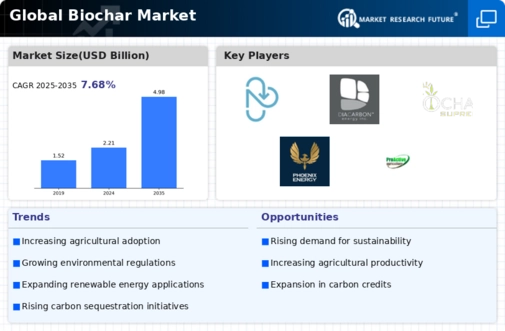Top Industry Leaders in the Biochar Market

The biochar market is a crucible of innovation and competition. This carbon-rich char, derived from organic waste through pyrolysis, is igniting interest across diverse industries, from agriculture to energy production. But beneath the surface of this burgeoning market, a fierce battle for market share is being waged. Let's delve deeper into the strategies, trends, and recent developments shaping this hotbed of activity.
Strategies Fueled by Growth:
-
Diversification: Leading players like Pacific Biochar and Aries Clean Energy are expanding beyond traditional soil amendment applications, venturing into bioenergy production, water filtration, and even animal feed additives. This mitigates risk and capitalizes on new growth opportunities. -
Technological Advancements: The quest for the perfect char is on. Companies like Dynamotive are refining pyrolysis processes, exploring different feedstocks, and developing new activation techniques to create biochar with enhanced properties for specific applications. -
Geographic Expansion: Emerging markets like China and India are fertile ground for expansion. Farm2Energy, for instance, has established partnerships in these regions to capitalize on the growing demand for sustainable agricultural solutions. -
Sustainability Focus: Green embers are glowing bright. Chardust Ltd. is leading the charge by developing carbon-negative biochar production processes and offering certified carbon offsets, aligning with environmental goals and attracting eco-conscious consumers. -
Vertical Integration: Gaining control of the supply chain is key. Airex Energy, for example, is acquiring biomass sources and establishing production facilities, ensuring quality control and cost-efficiency while reducing dependence on external suppliers.
Factors Shaping Market Share:
-
Application Focus: Different applications demand specific biochar properties. For soil amendment, high porosity and nutrient retention are crucial, while bioenergy production requires high calorific value. Companies like Black Diamond Biochar excel at tailoring their product to specific needs. -
Cost Competitiveness: Price remains a burning issue, especially for bulk applications in agriculture. Asian manufacturers often offer cost-effective options, while European and American players command premium prices for high-quality, specialized biochar. -
Regulatory Landscape: Government policies and subsidies can influence market dynamics. The European Biochar Certificate, for instance, facilitates the use of biochar in soil across several European countries, boosting demand in the region. -
Technological Innovation: New pyrolysis technologies, feedstock options, and activation techniques can disrupt the market. Companies like Biochar Solutions, Inc. are pioneering the use of fast pyrolysis for efficient biochar production, creating a competitive edge. -
Environmental Awareness: The rising tide of environmental consciousness is fueling demand for sustainable solutions. Biochar's ability to sequester carbon, improve soil health, and reduce fertilizer use makes it a compelling choice for environmentally responsible businesses and consumers.
Key Players:
- Novocarbo (India)
- Airex Energy Inc.
- Diacarbon Energy (Canada)
- ArSta Eco Pvt Ltd. (India)
- Biochar Supreme (US)
- Coaltec Energy USA (US)
- Farm2Energy Pvt. Ltd. (India)
- Frontline BioEnergy LLC (US)
- KARR Group Co. (KGC) (US)
- Pacific Biochar Corporation (US)
- Phoenix Energy (US)
- ProActive Agriculture (US)
Recent Developments:
July: The International Biochar Initiative releases a new report highlighting the potential of biochar in mitigating climate change, boosting market sentiment.
August: Pacific Biochar enters a strategic partnership with a major agricultural cooperative to supply biochar for large-scale soil amendment projects.
September: Aries Clean Energy successfully completes a pilot project using biochar in wastewater treatment, opening doors for a new application segment.
October: The US Department of Agriculture announces funding for research on biochar's potential in enhancing crop yields and reducing fertilizer use.
November: The European Union proposes new regulations on the use of biochar in animal feed, potentially impacting the market for this application.
December: A consortium of biochar producers and researchers launches a global initiative to develop standardized biochar quality and testing protocols, promoting market transparency and facilitating wider adoption.

